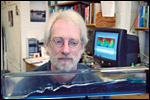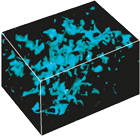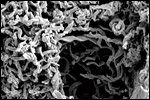
|
 |
Research > Science Highlights
Science Highlights
 |
Doing
the Wave
Surfers and satellites make unlikely oceanographic assistants,
but both are helping investigators from the Applied Ocean
Physics and Engineering Department study the basic physics
of ocean waves on scales varying from centimeters to hundreds
of kilometers. |
Picoplankton
and the Whale
"Great fleas have little fleas upon their backs to
bite ’em, /And little fleas have lesser fleas, and ad
infinitum. /And the great fleas themselves, in turn, have
greater fleas to go on; /While these again have greater
still, and greater still, and so on." |
 |
 |
From Tiny Grains, a Larger Understanding of Earth
Fifty miles below the ocean bottom, where extreme
pressure meets temperatures exceeding 2,000 degrees Fahrenheit, rock is squeezed and cooked until it begins to flow like hot syrup. This is the birthplace of magma, the molten rock that rises to erupt from undersea volcanoes or oozes from deep fissures,
cooling and solidifying as it hits cold seawater to carpet the seafloor with new crust.
|
Pumping Iron on the Seafloor
Somewhere on the vast seafloor that covers 70 percent of our planet lies a small rock. On that rock is a microscopic crevice, maybe 10 microns (0.0004 inches) deep and 20 microns wide. And in that crevice is a thriving community of microbes,
for whom that nook is as cozy and bountiful as Grandma’s house on Thanksgiving.
|
 |
 |
What Goes Down Must Come Up
From space, the ocean may look like a big, calm bathtub. But
below its surface lies the ultimate dynamic environment—328
million cubic miles of water flowing, sinking, mixing, and rising.
|
|
|
